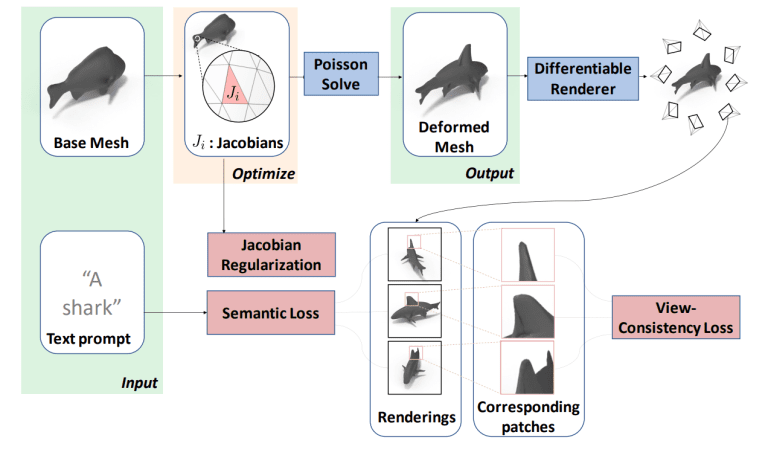TL;DR:
- Three-dimensional (3D) meshes are crucial in computer graphics and have diverse applications.
- Creating 3D meshes requires expertise, making customization challenging for non-experts.
- TextDeformer is an AI framework that automates the deformation of 3D meshes.
- It leverages text guidance and advanced rendering techniques to transform source shapes into desired targets.
- TextDeformer preserves semantic consistency and can handle both low-frequency and high-frequency shape changes.
- This framework revolutionizes the field of computer graphics, empowering artists and designers.
Main AI News:
In the dynamic world of computer graphics and 3D modeling, three-dimensional (3D) meshes play a pivotal role, finding applications in diverse fields like architecture, automotive design, video game development, and film production. A mesh serves as a digital representation of a 3D object, composed of vertices, edges, and faces that define its shape and structure. Vertices mark the meeting points of edges, while faces encapsulate the object’s surface.
Creating 3D meshes is a formidable task, typically reserved for skilled experts with artistic prowess. The process demands a level of expertise that makes it challenging for individuals without specialized knowledge to construct 3D meshes from scratch. While the internet offers a plethora of 3D object datasets crafted by digital artists, customization, even in its simplest form, entails an arduous and time-consuming editing process.
To address this challenge, the realm of computer graphics and geometry processing has focused extensively on the problem of mesh deformation. Many existing AI techniques allow users to manipulate deformations through control handles, enabling coarse, low-frequency alterations while preserving details—an attribute commonly referred to as detail-preserving deformations. However, in the realm of 3D modeling, incorporating fine geometric information remains a complex and time-intensive task, even for the most skilled artists.
Introducing TextDeformer, an innovative AI framework specifically designed to automate the process of 3D mesh deformation. TextDeformer endeavors to transform a given source shape into a desired target shape while ensuring semantic consistency between the two. Let us delve into an overview of this cutting-edge system workflow and architecture.
Unlike traditional approaches that heavily rely on 3D training data, TextDeformer capitalizes on the success of recent text-guided generative techniques and Neural Radiance Fields (NeRFs). It leverages differentiable rendering with pre-trained image encoders such as CLIP to precisely adjust and optimize the geometry of rendered objects.
Post deformation, the structure and properties of the source mesh remain intact, while the resulting geometry adheres to the text specifications. What sets TextDeformer apart is its focus on the deformation task, distinguishing it from previous text-guided works that generate geometry from scratch or augment existing mesh geometry while preserving input characteristics.
In essence, TextDeformer presents a framework meticulously designed to modify existing input shapes, generating high-quality geometry that faithfully represents the source mesh. Moreover, it possesses the remarkable capability to incorporate both low-frequency shape changes and intricate high-frequency details. For instance, it can elongate a cow’s neck to transform it into a giraffe or add scales when deforming it into an alligator. The authors emphasize the continuous and semantically meaningful correspondences achieved during the deformation process by employing a coloring technique on the source mesh, ensuring visibility and coherence in visualizations.
Conclusion:
TextDeformer represents a significant breakthrough in the field of 3D mesh deformation. By harnessing the power of AI and text guidance, it eliminates the need for specialized expertise, allowing non-experts to create customized 3D meshes with ease. This technology opens up new opportunities for various industries, including architecture, automotive design, video game development, and film production. With TextDeformer’s ability to preserve semantic consistency and generate high-quality geometry, it has the potential to reshape the market by enabling faster and more efficient 3D modeling processes. Artists and designers can now bring their visions to life with greater ease and precision, leading to enhanced creativity and innovation in the industry.

